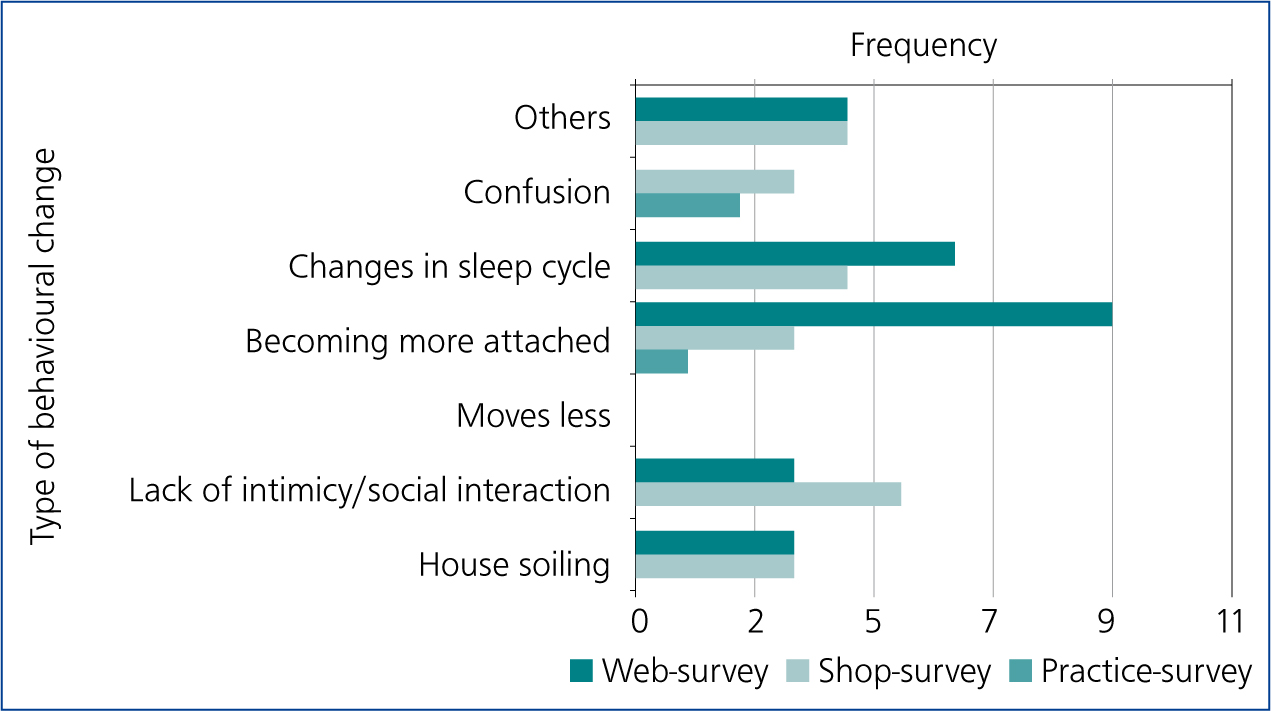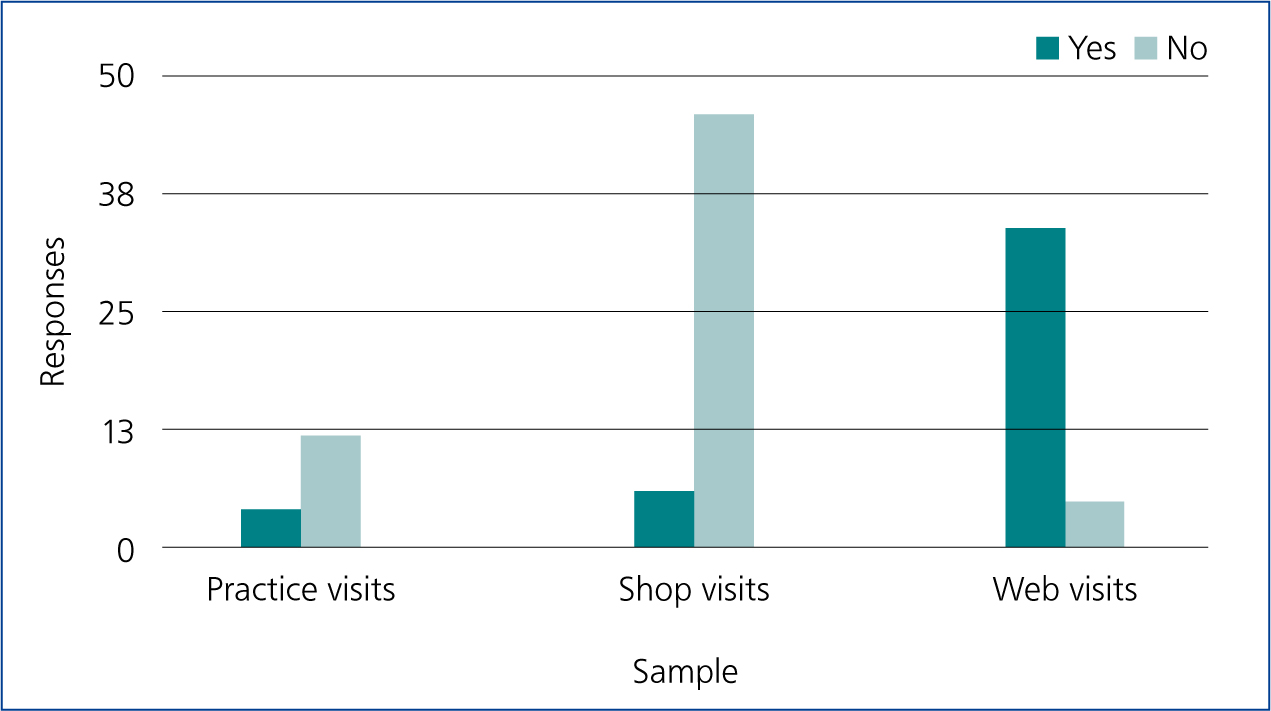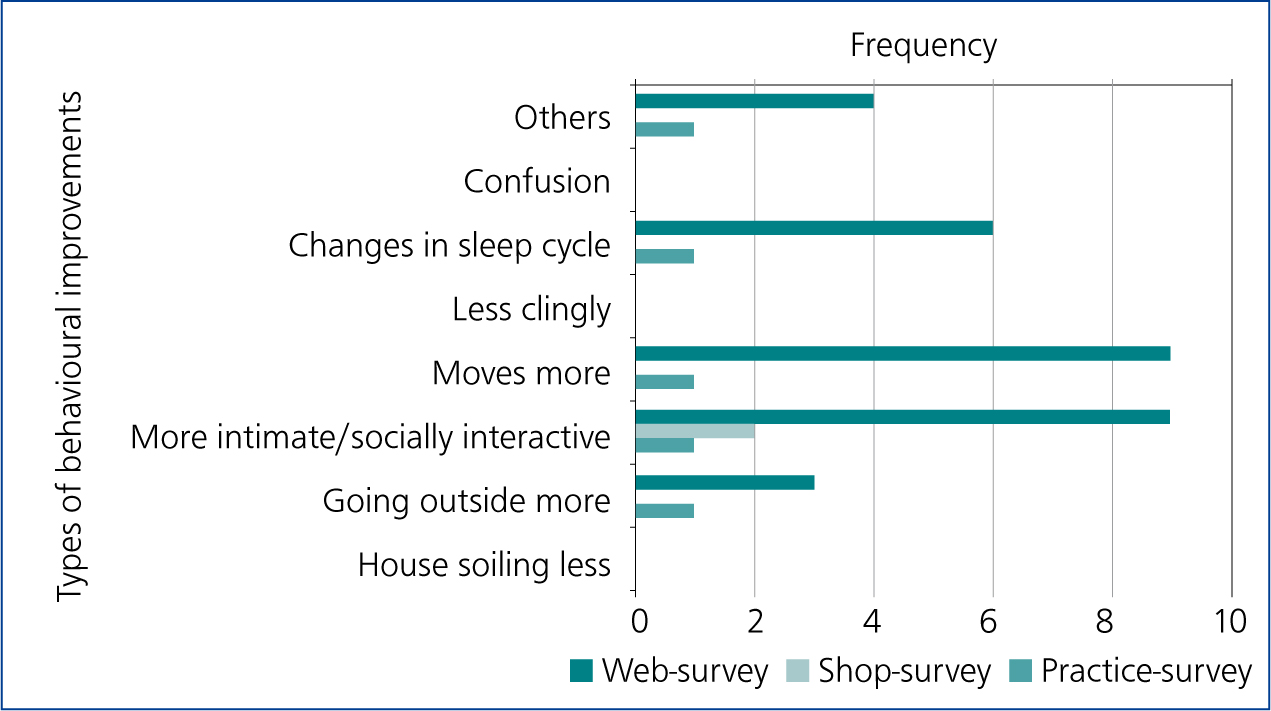Due to advances in veterinary medicine the average age of companion animals has risen by 70% since the 1930s (Gerrard, 2013; Critchley, 2014). This has led veterinary professionals to spend increased clinical time caring for the geriatric patient (Critchley, 2014). Bowen et al's study (2013) found 67% of dogs between the age of 15–16 years had mild to severe canine cognitive dysfunction (CCD), compared with 27.5% of dogs between the ages of 11–12 years old. Veterinary professionals are, therefore, likely to treat geriatric dogs with CCD. Possible supportive treatments are environmental techniques, which have been indicated to minimise stress and reduce progression of cognitive abilities in geriatric dogs suffering from CCD (Druce, 2014). Environmental enrichment has been considered relevant due to the possible improvements it may have on an animal's quality of life (Kerrigan, 2014) by delaying progression; however it requires early recognition of CCD (Fry, 2015). Subtle changes in behaviour are often early indicators that an animal may be developing CCD (Warnes, 2015a). Fry (2015) suggests that diagnosed cases of CCD are low which could possibly be due to owners confusing normal age-related behaviours with behaviours consistent with CCD.
The purpose of the research was to determine whether owners of older dogs are able to notice behavioural changes and understand the term environmental enrichment. In addition, it looked at whether environmental enrichment helps owners notice alterations in behaviour that indicate improved welfare, and which may also assist slowing the progression of CCD. The result of this study could help inform the veterinary profession in improving education strategies implemented during clinic consultation in order to help owners recognise behavioural indicators of CCD, which may help to improve welfare, and slow CCD progression in the geriatric patient.
Literature review
Canine cognitive dysfunction causes diminished cognitive function via an increase in damaged brain tissues, resulting in canine memory loss characterised by altered behaviours (Druce, 2014). Behavioural changes associated with CCD are often referred to as ‘DISH’ behaviours due to disorientation, interaction, sleep cycle changes and loss of house training (Ervin and Appleton, 2013). Although research in CCD has not found a definitive cause it has been recognised as a progressive condition that diminishes a dog's cognitive function to the point where ‘DISH’ behaviours are displayed often leading to owners and veterinary professionals having difficulty distinguishing between age-related behaviour and behaviours indicative of CCD (Ozawa et al, 2016). It is therefore important to educate owners on recognising diminished cognitive function and treatment options that delay CCD progression (Druce, 2014).
Preventative strategies in the form of environmental enrichment and social interaction aim to reduce the rate or onset of cognitive decline (Warnes, 2015b). Examples of environmental enrichment for dogs could be activity feeding which encourages natural foraging behaviours and mental stimulation via strengthening their problem solving capabilities (Warnes, 2015b). Ervin and Appleton (2013) support the weekly rotation of toys to be an important component of CCD management due to continuous mental stimulation. Milgram et al (2005) evaluated the effectiveness of behavioural enrichment with young and geriatric beagles to assess age-related cognitive decline over a period of 3 years. The results demonstrated that learning abilities progressively decline with advanced age but the rate of decline was delayed with environmental enrichment. However, age-related cognitive decline was greatly reduced in groups that received environmental enrichment combined with antioxidant supplements (Milgram et al, 2005). Although research indicated that environmental enrichment can reduce CCD progression in ageing dogs (Milgram et al, 2005; Ervin and Appleton 2013; Warnes, 2015b), the rate of cognitive decline must be considered before implementation as dogs with severe CCD often become stressed after experiencing changes in their routine and would therefore benefit more from a constant environment (Warnes, 2015b). Kerrigan (2013a) suggests that general signs of ageing could prevent dogs from engaging in forms of enrichment such as pushing or lifting toys to release food. Assistance from the veterinary team can help owners to devise alternative forms of environmental enrichment to help improve quality of life as well as social interaction (Kerrigan, 2014), both of which can be impacted by CCD (Druce, 2014).
Although the research suggests that the use of environmental enrichment can delay CCD progression (Ervin and Appleton, 2013), delaying further progression requires early recognition of CCD (Fry, 2015). Subtle changes in behaviour are often early indicators that an animal could be developing medical problems such as CCD (Warnes, 2015a). Salvin et al's (2011) study revealed that 14% of dogs over the age of eight, suffer from CCD but only 2% of cases were diagnosed. Head et al (2008) suggested that the gap between cases and diagnosis may be due to owners failing to report ‘DISH’ behaviours to the veterinary team because they consider them to be normal age-related behaviours (Fry, 2015). Heiblum's (2007) study supported the theory that the majority of pet owners only seek professional help when their pets show signs of disease that can no longer be tolerated by the owner (Kerrigan, 2013b). The veterinary team can therefore enhance owner education in regards to realistic expectations regarding treatment options around CCD, where environmental enrichment may indeed slow its progression and improve quality of life (Aitken, 2014). Research by both Druce (2014) and Critchley (2014) concluded that by practices offering senior clinics, both owners and their dogs can benefit through improved owner knowledge. Improved owner understanding regarding geriatric care enables owners to modify and adapt to their geriatric dog's lifestyle, which could possibly slow the progression of CCD (Critchley, 2014).
Methods
A questionnaire was distributed to owners that volunteered to participate and owned dogs over 7 years of age. Data collection took place in two veterinary practices as well as a pet store from December 2016 to February 2017. In addition an online questionnaire was created and launched within a veterinary nurse chat room available to both qualified and student veterinary nurses in January 2017. Participants were placed within three groups: the first group represented participants from the veterinary practices; the second group of participants from the pet store; and third group included participants from the online survey. All participants were given the same questionnaire and no pilot study was conducted.
The questionnaire consisted of 11 questions that used a quantitative approach (Box 1). One question identified whether the dog owner noticed a change in behaviour in the past 6 months and then moved on to identify the type of behaviour observed. The types of behaviours that were included in the multiple choices referred to behavioural deficits concerning disorientation, interaction, changes in sleep cycle and loss of house training. These behavioural changes have been considered relevant to the characterisation of CCD in geriatric dogs. Data were then analysed using the statistical package ‘minitab’ using the chi-squared test for association. Prior to collecting any data ethical approval was obtained through Askham Bryan College ethics board.
Results
The study included 107 participants; 40 respondents worked within the veterinary field, 33 of which participated via the web survey. Participants within the three groups comprised 16 from the two veterinary practices, 52 customers visiting the pet shop and 39 responses via the web survey.
The data were analysed using the statistical program ‘minitab’ by performing chi-squared tests for association. Statistical analysis indicated that web visitors which were primarily composed of respondents working within the veterinary field were more likely to notice a change in behaviour in geriatric dogs (χ2 = 10.752, df=2, p=0.005).
In all groups (veterinary practice, pet shop and web survey), some owners did observe the frequency and range of behavioural changes that can form a canine cognitive dysfunction diagnosis. The types of behaviour and frequency observed from respondents from each group are presented in Figure 1.

Further statistical analysis demonstrated that respondents from the web survey who owned a geriatric dog were more likely to be familiar with and use environmental enrichment techniques (χ2 = 54.684, df=2 p=0.000). The web survey participants comprised predominantly veterinary professionals (Figure 2).

Although the study suggests that there is no statistically significant differences regarding owners in any group reporting behavioural change after implementing environmental enrichment (χ2 = 1.088, df=2, p=0.580), some owners did observe some behavioural improvement (Figure 3).

Discussion and limitations of the study
CCD syndrome is characterised by altered behaviours which has caused difficulty in evaluating clinical presentations of CCD and separating them from ageing behaviours. Salvin et al's (2011) survey determined a cluster of 13 behaviours which form a CCD rating scale that when combined helped to determine a veterinary diagnosis of CCD (Druce, 2014).
The Salvin et al study (2011) highlighted that CCD is under-diagnosed with around 85% of unidentified animals possibly suffering from CCD. Low presentation rates of CCD may be due in part to owners considering it a normal part of the ageing process (Salvin et al, 2011). Participants of this study may have observed neurobehavioral disturbances indicative of CCD but thought irrelevant to mention due to considering them part of the ageing process which could have affected the study's reliability. Further limitations of the study included sample size and bias during sampling towards respondents working within the veterinary profession.
The results show that from the veterinary practice group, 21% of participants worked within the veterinary profession. Only 7% worked within a veterinary-related industry from the pet shop group; however 84% of participants from the web-survey worked within the veterinary profession. The web survey comprised predominantly veterinary professionals and within this study, this group was more likely and able to recognise behaviour changes in geriatric dogs.
From 107 respondents, 42 observed one or more changes in their geriatric dog's behaviour. Behaviour changes associated with CCD are referred to as DISH behaviours — disorientation, interaction, sleep cycle changes and loss of house training (Ervin and Appleton, 2013; Kerrigan, 2013a). DISH-related behaviour changes were noticed by 31% of respondents (pet shop group), and 59% of participants from the web survey. The most common behaviour change noticed was increased attachment. This is a behaviour associated with a change in pet–owner social interaction, a recognised symptom of cognitive dysfunction (Critchley, 2014).
The results indicate that pet owners may benefit from education provided by veterinary professionals in identifying the differences between age-related behaviours and neurobehavioural disturbances possibly indicative of CCD. Landsberg et al (2010) also highlighted the relevance for veterinary practices to become more proactive in their approach to supporting owners in recognising and reporting behavioural signs that might improve diagnostic evaluation (Fry, 2015).
Veterinary professionals are also more likely to understand the term environmental enrichment. This is not to say that the average pet owner does not perform enrichment activities with their dog, but that they demonstrate a lack of knowledge regarding terminology. Environmental enrichment focuses on providing positive interactions between an animal and human which can range from petting to exploring new surroundings through walks (Kerrigan, 2014). An animal's cognitive function refers to their mental processes that include perception, awareness, learning, memory and decision making (Fry, 2015). Cognitive dysfunction is associated with the gradual weakening of these mental processes (Warnes, 2015a).
Research suggests that mental stimulation in the form of environmental enrichment can slow cognitive decline by improving circulation and oxygen flow to the brain (Warnes, 2015b; Kerrigan, 2013a). In addition, CCD can impact the human–animal bond due to the decreased response to taught cues and reduced interaction (Druce, 2014). It may therefore, be beneficial for veterinary professionals to educate owners on and promote use of environmental enrichment techniques with their geriatric dogs to limit cognitive decline progression and minimise damage to the pet–owner relationship. Although this study found no association, behavioural improvements post implementation of environmental enrichment may be revealed within a larger study. However, in this study, the most common improvements observed were improved social interaction, raised activity levels and changes in sleep cycle.
Veterinary professionals are in the unique position to both educate owners on behavioural recognition of cognitive dysfunction and on environmental techniques to slow down cognitive decline (Fry, 2015). By implementing preventative strategies throughout a dog's lifetime it will help to assist in retaining cognitive reserves and help to slow cognitive decline later in life (Warnes, 2015b).
Conclusions and suggestions for further research
In order to help educate pet owners to notice behaviour changes in their geriatric pets, it may be beneficial to initiate discussion during nurse and senior health check visits. Pet owners appear to have difficulty recognising and differentiating between age-related behaviours and neurobehavioral disturbances which possibly indicate the presence of CCD.
Education of owners may result in a higher number of geriatric dogs with behavioural indicators of CCD being referred to the veterinary surgeon as well as the swift implementation of environmental enrichment techniques that are designed to slow the progression of CCD. Although this study found no statistical difference between the application of environmental enrichment or doing nothing, owners did still indicate some noticeable behaviour changes regarding social interaction, increased activity levels and sleeping patterns in their elderly dogs when environmental enrichment was provided.
Further research is suggested using CCD rating scales to help increase diagnosis rates, re-evaluating owner knowledge in their ability to differentiate between age-related and CCD behavioural changes, and further studies in the use of environmental enrichment and its potential as a treatment aid in CCD cases.

